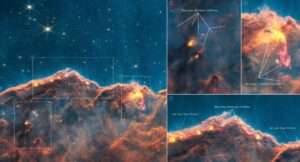The James Webb Space Telescope, NASA’s ambitious and powerful space observatory, has been unlocking the secrets of the universe with its revolutionary technology. From the mesmerizing end stages of a dying sun to the mesmerizing birth of actively forming stars, the telescope’s recent captures have left scientists and astronomy enthusiasts in awe.

The James Webb Space Telescope (JWST) has captured stunning images of dying stars and actively forming stars. The images, offer a glimpse into the final stages of stellar evolution and the early stages of star formation.
A Glimpse into the Sun’s Future
The James Webb Telescope’s exceptional capabilities allowed it to peer into the distant future of our own star, the sun. Capturing the end stages of a dying sun, the telescope revealed a stunning display of cosmic drama as the sun ages and transforms. The images and data collected provide critical insights into the fate of our solar system, offering a glimpse into what lies ahead for our own celestial body.
A Canvas of Stellar Nurseries
Apart from examining the end of stars’ lives, the James Webb Telescope also took a closer look at the beginning of new ones. Its observations of actively forming stars within stellar nurseries showcased the breathtaking beauty of cosmic creation. These images displayed vast clouds of gas and dust giving birth to newborn stars, each shining brightly in the vastness of space.
Revolutionary Technology at Play
The James Webb Telescope’s achievements are a testament to the cutting-edge technology and engineering prowess that went into its development. Its advanced instruments, including the Near-Infrared Camera, Spectrograph, and Mid-Infrared Instrument, provided unprecedented clarity and sensitivity, enabling it to capture the most distant and faint objects in the universe.
The Thrill of Discovery
Each new discovery by the James Webb Telescope has been met with excitement and anticipation among astronomers and space enthusiasts alike. The telescope’s ability to peer deeper into space and time has allowed scientists to unravel some of the universe’s most profound mysteries, making it an invaluable asset to humanity’s quest for knowledge.
Pioneering the Future of Astronomy
The James Webb Space Telescope is a testament to human ingenuity and the spirit of exploration. As it continues to unveil the mysteries of the cosmos, it is also paving the way for future space observatories and groundbreaking discoveries. Its observations will influence our understanding of the universe for generations to come, inspiring new generations of scientists and explorers.
A Cosmic Journey Unfolds
As the James Webb Telescope continues its cosmic journey, scientists eagerly await more captivating discoveries that will deepen our understanding of the cosmos. Its observations will shed light on the origins of stars, galaxies, and planetary systems, unraveling the mysteries of our existence in the vastness of space.
The Legacy of Exploration
The James Webb Space Telescope stands as a symbol of humanity’s unyielding spirit of exploration and our insatiable curiosity about the universe. With each image and data point it sends back to Earth, it reinforces the idea that the cosmos is a vast canvas of wonders, waiting to be explored and understood.


The JWST images are the first of many that the telescope will capture. The telescope is expected to revolutionize our understanding of the universe, and these images offer a tantalizing glimpse of what is to come.
